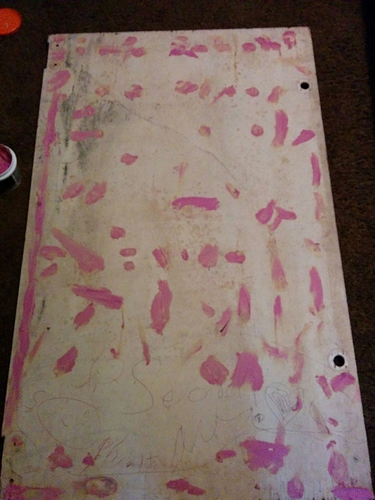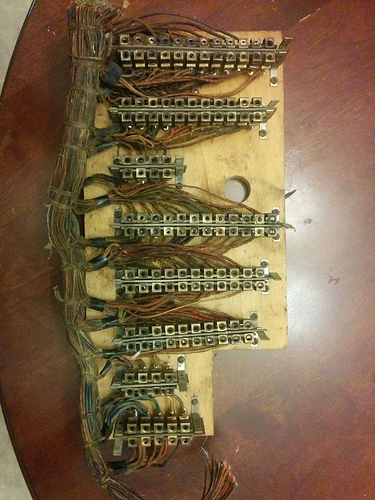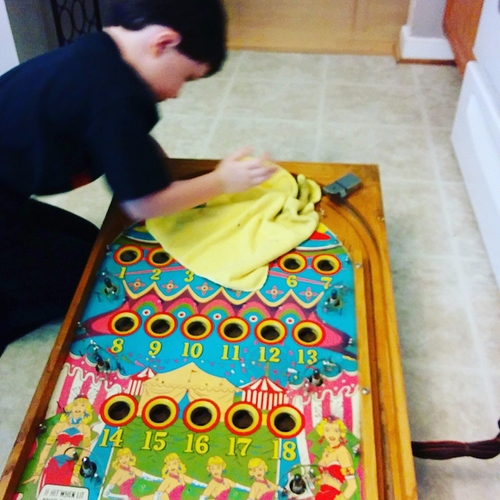I have been working since about March of this year on a custom-built pinball machine.
I particularly love restoring and playing the bingo pinball machines (games with 20 or 25 holes in the playfield and a 5x5 bingo card on the backglass), and I have realized that it is unlikely that I would ever experience all of the bingo pinball machines ever created by four different companies in the US alone, across 30 years - 1951 - 1981.
With some words of encouragement and a generous donation of a scrap cabinet and parts to complete the exterior, I set to work.
I hand-drafted a schematic in the style of the games produced in the 1960s, lovingly hand-wired the entire game (with period-appropriate wire ties), programmed the whole thing, and now it is playable, wonderful, challenging and exactly what I envisioned before I began.
Utilizing the P3-ROC hardware, I was able to use the standard 25 hole playfield layout, and I have programmed 40 games, selectable through a menu, which can be individually loaded and played. I have worked very hard to try to simulate the mechanical randomization efforts of each machine, by studying schematic drawings, manuals, and in some cases, playfield or backglass photos. I have had help with the backglass artwork for some games, and others I have had to touch up from postage-stamp sized photos, taken when digital cameras were just coming into fashion.
Once I started the machine for the first time, and was able to play (and win!) on a game, I was thrilled. I added more and more games, games that are only rumored to exist, games of which only a one or only a handful remain today in the world, and full production games.
I will continue to add games to the machine, until all 130-odd games are simulated. Playfields will be swappable, between 18, 20, 25, 28, 24 hole and other oddball sizes. The software will automatically restrict your playing choices to the available games for that playfield. I am also working on the exterior artwork for the game, which is an ambitious project in and of itself.
The game will fire off the free game knocker, the free game bell or just the sounds of the replay register ticking up with each credit earned or played, based on how the actual game is documented. Each manufacturer and era of production was slightly different.
The last part of this project is that I am going to design my own unique bingo pinball machines - utilizing similar portioning and controls as the EM bingos made for those three decades in the United States. However, I can greatly expand on the already incredibly complex rulesets as I am not bound by the space inside of the cabinet to hold all of the mechanical units.
I am incredibly excited to share this creation with the world, and I am doing so next week at the White Rose Gameroom Show in York, PA. September 30th and October 1st at the York Fairgrounds. If you are coming to the show, please stop by and see the monstrosity I have wrought.
There is great satisfaction to me in restoring a game, using the skills learned from friends and my own mechanical and electrical aptitude to bring a dead amusement device back to life; but there is an entirely different thrill to the art of creation.
I would encourage you to check out the below video, where you can see the menu and hear me talk a bit about the games available: https://youtu.be/HCYIQdP-aic
If you plan on attending the York show, please stop by and say ‘hello’. I’d love to show you the game! We are also doing another Bingo Row this year. It should be even bigger and better than last year. Last year, I gave away an autographed copy of Bally Bingo Pinball Machines or The Bingo Pinball War: Bally Vs. United by Jeffrey Lawton. This year, I commissioned Ryan Claytor to design a t-shirt for the Bingo Row, and you can win one of those beauties for free if you make a four or five in a line on any of the Bingo Row machines.
I’m always happy to answer any questions that anyone may have.
Thanks for reading,
-Nick
 See you at York!
See you at York!






















